Watch These Top Retail Design Trends in 2022
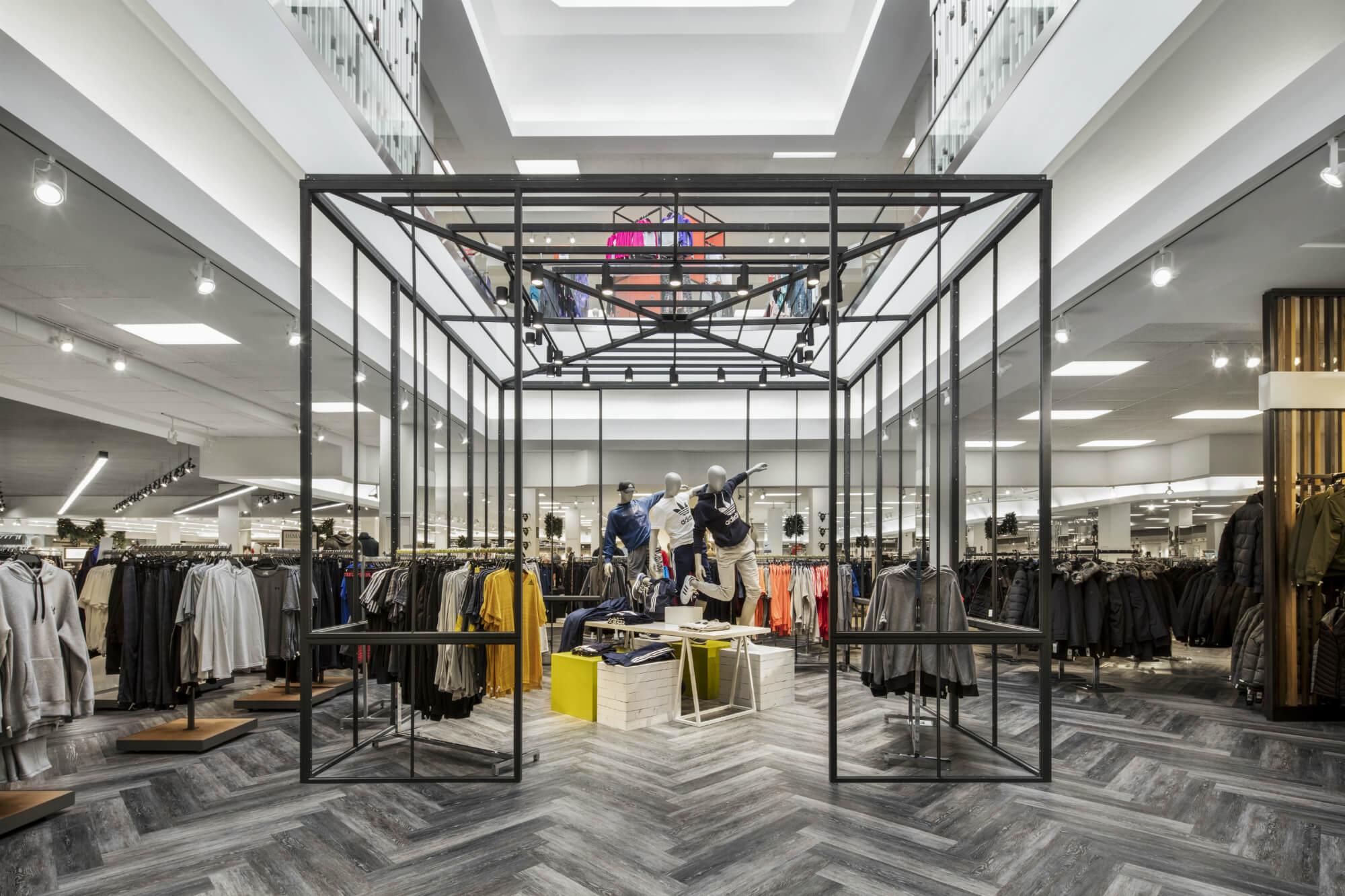
Hudson’s Bay Gatineau QC | Photo: Adrien Williams
The retail shopping experience took an unprecedented turn in 2020 due to the global impact of COVID-19 with online sales, eCommerce websites and curbside pickup taking over the traditional in-person shopping experience.
Even before COVID-19, it was clear that online shopping was here to stay and would be a major factor when it comes to retail trends.
According to recent studies, 76% of U.S. consumers shop online, and it’s projected that there will be more than 300 million U.S. online shoppers in 2023.
Online shopping provides convenience, optimal pricing, and oftentimes more selection and options than traditional retail stores.
With such service at your fingertips, the design of a physical store is now more important than ever. And even though the shopping experience shifted in 2020, brick-and-mortar stores aren’t going away. In fact, 46% of consumers still prefer visiting a physical retail location over online shopping, according to a recent survey, and when these consumers receive a positive in-person shopping experience, 90% will likely return to that business.
As the economy starts to open up again, many consumers are still opting for the in-store retail route because they can see what they’re buying (and speak to a sales representative) in person before purchasing. Businesses that want to give themselves the most opportunities to succeed blend the best of online and retail shopping (brick-and-click), catering to every type of consumer.
Design innovation is a vital tool for retailers to set themselves apart and draw customers into their stores. Each retail space, regardless of industry — department store, supermarket, drug store, boutique, etc. — should incorporate some of these Retail Design Trends to Watch in 2022 into their spaces.
- Brand Storytelling/Design for Demographics
- Interactive Shopping Experience
- Technology
- Increased Convenience
- Sophisticated & Minimalistic Merchandising
- Comfortable & Inviting Home-Like Design
- The Power of Social Media
- Pop-Up Shops
- Natural Lighting
- Wayfinding for Floor Designs
1. Brand Storytelling/Design for Demographics
Brand storytelling is more important than ever, as the retail shopping experience has become about more than just browsing and purchasing products. One of the top design trends for 2022 is using the power of storytelling to showcase a brand’s values, which is crucial as retailers try to maintain customers and attract new ones.
Brand storytelling is the cohesive narrative that weaves together the facts and emotions that your brand evokes,” according to a Forbes article. “In addition to giving your customers reasons why they should buy a product or service, businesses need to start sharing the story behind their brand, why it exists, and why this matters, consistently across all communication.” It allows a retailer to stand apart from competitors; build a strong, trusted customer base; and create a big impact.
But businesses also need to be aware of the toll technology has taken on consumers, notably lowering attention spans from 15 to 8.25 seconds. Retailers should experiment with telling their story in different ways and through different platforms, such as videos, social media stories, podcasts, blog posts and even through merchandise such as T-shirts and mugs.
Patagonia is a good example of brand storytelling. The outdoor clothing and gear company puts its passion for sustainability and environmental action front and center in messages, advertisements and social media content.
For example, the company advocates reusing clothing when possible, so they offer customers the option of visiting a Patagonia store to drop off used clothing that’s no longer wanted (there is also an option to mail in garments, too). Customers who do so are issued a credit toward their next Patagonia purchase. Clothing that’s traded in is then sold through Patagonia’s Worn Wear program. In another example, the Patagonia Denver location prides itself on being “dedicated to preserving Colorado’s natural beauty” and the retail space features a variety of photos of the state; the store’s private rooftop and backyard area also hosts music, workshops, yoga and a meeting space for local nonprofits.
The company also has entire section on the Patagonia website dedicated to environmental and social responsibility.
When it comes to brand storytelling, it’s also important to remember visual components. Interior designer Amelia Papadakis from Bergmeyer explained, “Wow moments are still happening but in a more purposeful way. Storytelling graphics help make the in-store experience more authentic and meaningful.”
When designing a retail space, considering your audience or target demographic is a foundational step in the process. Identifying that group or groups and then choosing design elements that appeal to that demographic is a creative and strategic way to draw people in to your stores.
For instance, a children’s clothing store may want to focus on bright colors on the floor and walls and other pops of color throughout the space. An outdoor retailer may use more earthy tones in their color palette and feature imagery of famous trails or mountains.
Because it’s targeted, this appeals to the customized experience consumers expect today.
“If a customer gets a clear point of view of who you are as a brand and can walk out of the door being able to describe their experience in one sentence, you have success,” said Lion’esque Group Founder Melissa Gonzalez.
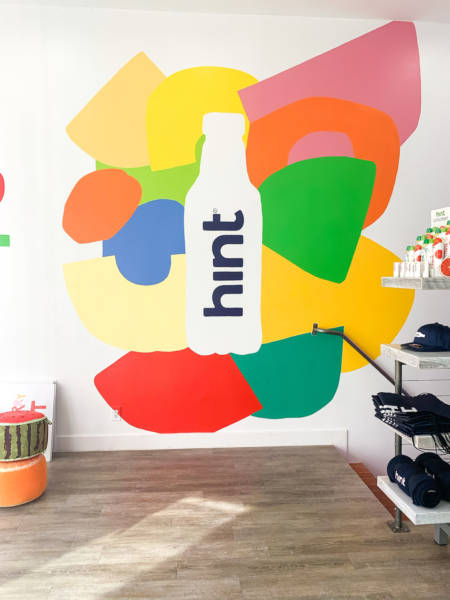
Hint Concept Store | San Francisco, CA | Parterre LVT in 3mm Fogged French Oak
2. Interactive Shopping Experience
The shopping experience pivoted in 2020, with online orders and curbside pickup options dominating the retail scene. Now, as stores begin to welcome customers back in greater numbers, while trying to compete with the appeal of online shopping, retailers need to hone their creativity skills when it comes to the physical design of their stores and how they engage customers with their products. It’s not just about the experience of going to a store in person, but the experience customers have while inside the store.
Retailers must cultivate an atmosphere of safety and comfort, while also providing an entertaining and enjoyable experience that appeals to all customers. And while physically holding or trying out certain items may be limited in some stores, others are still encouraging product interaction — but with safety precautions.
For example, you can browse for a new pair of frames at LensCrafters, but now glasses are disinfected after customers try them on. In many stores, one-way aisles, plexiglass barriers at cash registers and signs and floor decals that encourage social distancing are common.
3. Technology
Technology also continues to dominate the retail shopping experience by providing both convenience and entertainment. QR codes, in particular, have become more popular, especially as a contactless way to shop. QR codes can also be used to enter customers into a contest or giveaway, administer feedback surveys, and capture discount coupon codes, according to a Small Business Trends article.
Robots have also become a popular options for retailers, doing “everything from floor cleaning to material handling and now shelf analytics,” as explained by TechRepublic.
At GIANT food stores, Marty the robot is “used to identify hazards, such as liquid, powder and bulk food item spills and provide reporting that enables quick corrective action. The robots’ efforts free up associates to spend more time serving with customers.”
At New Balance’s flagship store in Brighton, Mass. customers can get a 3D scan of their foot, giving them the exact specifications and ideal fit for their shoe purchase. They then watch their shoes being made in the shoe manufacturing area. Customers can even stop by the “customization bar” where they can customize sneakers and have them shipped to their homes.
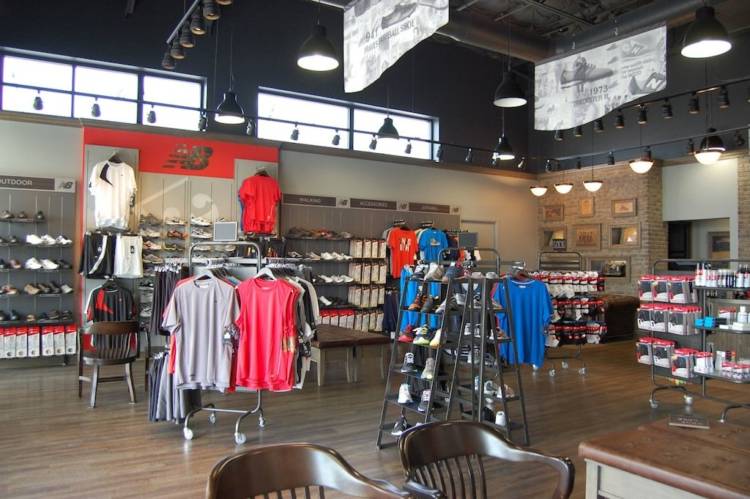
New Balance Union Park | Midvale, UT | Parterre LVT in 3mm Lancaster Patina
The website for Nike’s House of Innovation flagship store in New York City boasts that every floor “will offer unique and immersive experiences designed to serve consumers throughout the entire shopping journey.” The 6-level store features The Nike Arena, where customers can access the brand’s seasonal collections, and The Nike Sneaker Lab, which in addition to displaying a large selection of footwear, includes Nike storytelling.
Technological enhancements to the retail experience can mean everything from smart technologies to using customer-driven data.
H&M tested a “smart mirror” in its flagship store in New York City in which customers “could voice commands to take selfies that are virtually integrated with the H&M catalogue,” according to Business Insider.
The Nike Speed Shop, located at the company’s flagship store in New York City, uses local data to stock shelves – and then restock them based on the community’s desire.
You can use the Target Circle app in the store to find deals for the products in the aisles right near you. Plus, you can use the app to scan barcodes of product to see any available deals or discounts.
4. Increased Convenience
Digital shopping capacity is increasing – which means that the physical locations for some retailers is decreasing. One out of every four people is an online shopper, according to Oberlo, which means it is not necessary for some retailers to have such a large space or a full inventory on hand at brick-and-mortar locations.
Smaller or fewer shops, combined with eCommerce, provide multiple ways for customers to make purchases, and in 2020 the options of curbside pickup and buy-online-pickup-in-store grew in popularity. In other words, it’s all about increased convenience and whatever works best for each consumer.
Some retailers are choosing to start from the beginning with a new small location. For example, Target has opened a number of “small format” stores, which allow the company to “bring the best of the Bullseye into urban neighborhoods, near colleges and other areas where a full-size Target wouldn’t fit,” according to the company’s website. The stores average around 40,000 square feet (in comparison, full-sized Target stores are 130,000 square feet). The goal is to stock the stores with inventory that will best serve the surrounding neighborhood and community.
IKEA opened a small planning studio in New York City’s Upper East Side, which the company says, “is significantly smaller than our traditional blue box stores, but is a brand new way for customers to experience and interact with IKEA.”
The space features a range of home design options for small living spaces, which caters to the surrounding clientele. Customers can also book free design appointments with an employee.
These smaller spaces allow retailers the flexibility to change the furniture and style more quickly over time, depending on customer needs, products, inventory and trends.
5. Sophisticated & Minimalistic Merchandising
Though the shopping experience in 2020 may have been more digital than in-person, one of the store design trends for this year continues to be sophistication. In the past, retailers often stocked shelves with as much product as possible. Inventory was out for the customer to see and purchase – but one of the store design trends for 2022 is the idea of a more sophisticated shopping experience, which includes greater finesse and refinement in store design and inventory display.
An angular floor plan, for example, uses curves and angles to provide a sense of sophistication. It is a design that “reduces the amount of display you have but focuses instead on fewer, more popular lines,” according to the Vend blog. This floor plan can be particularly effective if you’re looking to showcase a particular product.
A more sophisticated shopping experience can also mean that less inventory is displayed on purpose.
“In retail, space conveys value,” the Vend blog explains. “The more space there is in a store or display, the higher the perceived value of the merchandise. This is why many luxury retailers display items in standalone cases while discount stores overstuff their shelves with merchandise.”
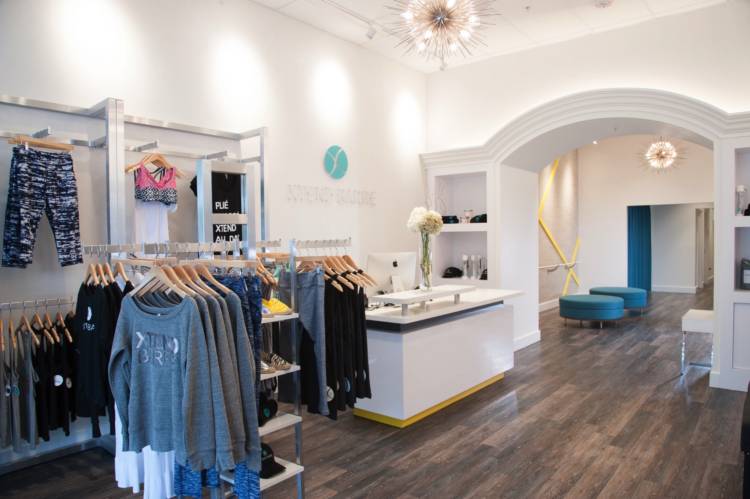
Xtend Barre | Boca Raton, FL | Parterre LVT in 3mm Starry Oa
6. Comfortable & Inviting Home-Like Design
Retailers want customers to feel safe and comfortable, and a lot of that stems from an inviting home-like design, which is a growing retail trend that has become increasingly popular in the interior design industry as a whole.
This kind of design essentially means creating a comfortable, inviting, home-like atmosphere. Many in the restaurant and hospitality industry have incorporated these design elements, and now retail stores are seeing the appeal of creating this type of atmosphere. The idea is that if customers feel comfortable, they’ll want to spend time in the store and/or revisit the space in the future.
Wood flooring can make a space warm and welcoming; engineered hardwood and wood-look LVT are great for this trend.
Many stores are also including different services in their spaces that add to the experience of shopping in person. For example, supermarkets and larger retailers host coffee chain restaurants within their stores, so shoppers can get their caffeine fix while picking up the items they need.
7. The Power of Social Media
The power and prevalence of social media has never been greater. According to the Harvard Business Review, social media spending increased from 13.3% of marketing budgets in February 2020 to 23.2% in June 2020, and “companies are seeking a historic return on their social media investments.”
In 2020, social media provided a way for consumers to see how their favorite brands and retailers were adapting to unparalleled circumstances. Even before COVID-19, retailers used social media to provide business updates, announce important information, highlight new products, offer giveaways and more. In 2020, social media also became an important communication tool as posts featured updated business hours, safety and cleaning protocol information, and adapted business models, such as take-out only or curbside pickup.
With shoppers active on social media, companies who are designing or redesigning their physical locations should consider an aesthetically pleasing space that shoppers will want to photograph or pose in front of — once they feel safe to do so. This social media phenomenon not only makes the shopping experience interactive, it is a great way for companies and businesses to get free marketing and further promote their brand.
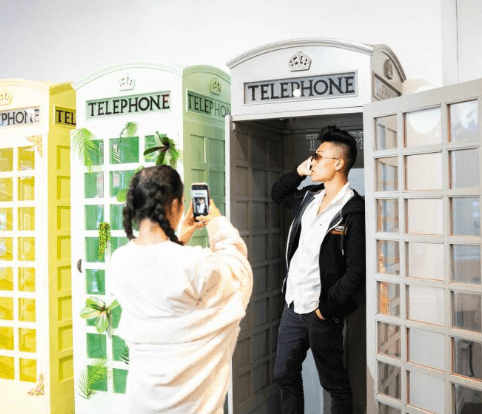
Photo courtesy of Pop Up Mob
Brian Weltman, CEO of Retail Habitats, is seeing this shift in the trends of retail store design. “A visit to a brick-and-mortar space is more about the experience than anything else. For this reason, we are now taking what used to be considered much needed real estate for products and reallocating it for decorative installations for the ever-so-important Instagram-able moment,” he said. “Retailers are starting to see that the equity social media posts can bring to their brands is more valuable than just a product on a shelf.”
To accomplish this as a designer, there are countless elements you can feature. It can begin with eye-catching floor or wall installations in interesting patterns like basket weave or herringbone. Then, experiment with neon or chalkboard signage with catchy phrases, paired with intriguing backdrops for photo ops. Retail trends today are seeing brands get creative about design elements that inspire customers to take photos inside the store and share them on social media. Integrating a Instagram selfie station is another fun option.
One retailer who has mastered this is the concept store Story in New York City, which describes itself as follows: “Point of view of a Magazine | Changes like a Gallery | Sells things like a Store.” Every few weeks they switch up the entire design of their store and what they’re selling, so it entices people to come in and see what’s new and different. Previously, Story was strictly a beauty retailer for well-known makeup brands, but they have reinvented their brand, their products and their shopping experience to draw every kind of shopper.
8. Pop-Up Shops
Just as companies are designing stores with fun new accents for social media opportunities, they are also setting up pop-up stores with the same motivation, and outdoor pop-up shoes have especially been on the rise.
These unique, “for a limited time” experiences appeal to millennial consumers and provide ample opportunity to spread brand awareness.
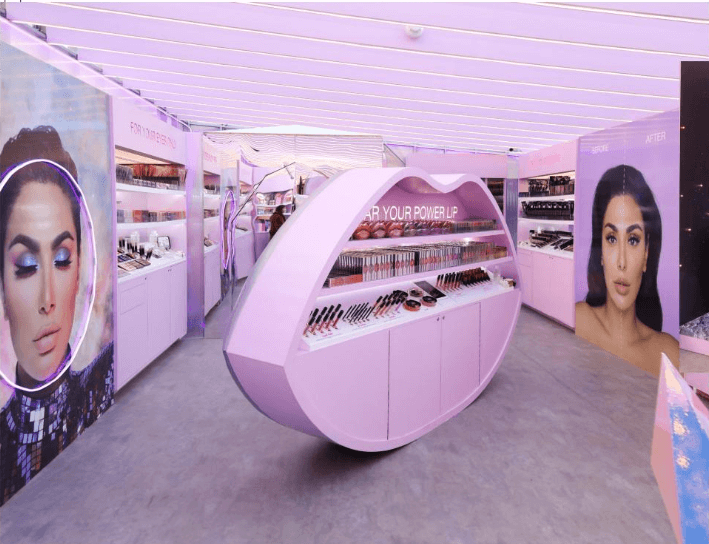
Photo courtesy of Pop Up Mob
“Customers can create memories and truly connect with a brand,” said Ana Pelucarte, CEO of Pop Up Mob. “Pop ups go way beyond transactional retail experiences which is what stores have offered for the longest time.”
In 2020, outdoor pop-up shops created a way for customers to shop in a safer, more open-air environment. In one example, the Chicago Makers Pop Up Shop opened in December 2020 for the holiday season, featuring 30 locally owned businesses, and has since found a permanent home.
Pop-ups are spreading to eCommerce businesses, who are opening temporary stores to test out a neighborhood and get a feel for the performance of their products or services in a real physical space. This can be a preliminary step to opening a permanent location, though some eCommerce retailers do this only temporarily.
9. Natural Lighting
If the space allows, it’s best to incorporate as much natural light (or the effect of natural lighting) as possible into a retail environment. According to RetailBiz, natural light is a mood booster; it also enhances the appeal of products and allows consumers to get a more precise sense of color.
“Choosing the correct color temperature, which is measured by its K (kelvin) rating, of LED bulbs is integral to a retail space,” according to Alcon Lighting. “Color temperature can create either a warm or cold environment and affect how products are displayed.” The company recommends 4,000 to 4,500K bulbs for a natural lighting effect, which is optimal for retail dressing rooms and grocery stores.
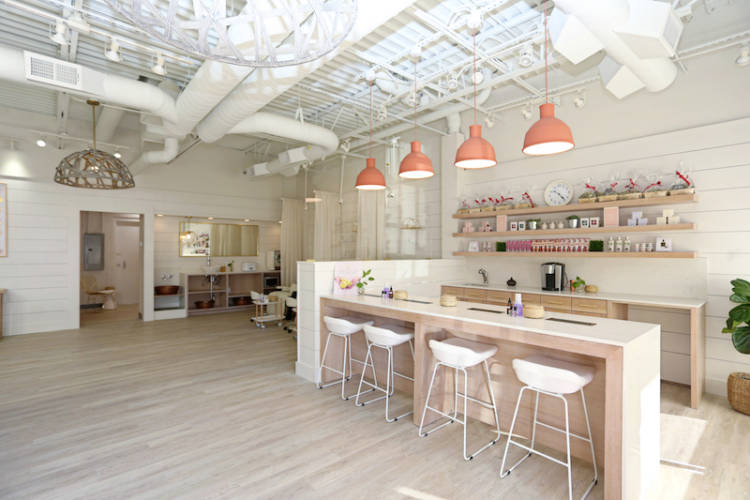
Sweet Mia Nail Spa | Tulsa, OK | Parterre LVT in 3mm Snowy Oak
10. Wayfinding for Floor Designs
Retail stores have long used flooring design to help shoppers navigate their way through different sections within the store, but it took on a new meaning in 2020. Floor decals, graphics and signs now indicate one-way aisles and remind shoppers to socially distance.
But wayfinding can also be aesthetically pleasing. It’s common in department stores and supermarkets to install flooring in a specific pattern that guides shopper traffic throughout the store. As it turns out, flooring design is both an art and a science.
A supermarket, for example, typically puts the items they want people to pay the most attention to at the front of stores and around the perimeter. Because of this, those areas tend to have their own designated flooring material that will subconsciously steer shoppers through those areas.
Other retailers, regardless of industry, should consider using specific wayfinding layout designs in their stores. Businesses can use flooring design to guide customers to the products they especially want to feature, or even to an accent wall or eye-catching neon signage designed to generate social media buzz. Retailers can use thoughtfully selected flooring designs to strategically guide customers through their store.
No matter the flooring designs or retail trends included in your store’s design, your flooring choices need to hold up under the foot traffic expected in brick-and-mortar stores. Engineered hardwood and LVT are both amongst the most durable and aesthetically pleasing options for commercial spaces and have been trusted by retailers for decades.
—
Retail design is especially important this year as businesses look to please existing customers and attract new ones. From residential-commercial, or “resimercial” design and pop-up shops to increased lighting and aesthetically pleasing wayfinding options, consider some of these Retail Design Trends to Watch in 2022 to take any retail space to the next level.
If you have any questions about Parterre’s flooring or wall products or how we can help with your next store design, please don’t hesitate to contact us.
Roche FitzGerald
Roche FitzGerald, Lead Product Designer for Parterre, is a second-generation artisitc giant in the flooring industry developing an appreciation for art and physical composition from his father, who was also an artist and leader in surface design.
“The mindset I have when creating art is that accidents are beautiful, which is something my father instilled in me,” said Roche. “There is an allure to discovering organic textures, patterns, and colors.”
A true artist at heart, Roche shapes designs from his own paintings or the inspirations of daily life. In the early 2000s, while other companies were turning to their manufacturers for options, Roche led the way in producing original flooring designs earning multiple industry awards and recognition for his luxury vinyl designs.
Polished Concrete vs. Vinyl Flooring
Polished Concrete vs. Vinyl Flooring Polished concrete vs. vinyl flooring. It’s not an easy decision, considering both provide an excellent solution for commercial flooring. The look of concrete floors has been a growing trend for commercial interiors.
Chevron and Herringbone
Break the Pattern of Commercial Flooring You can add more flair to your commercial flooring by breaking from the look of traditional straight-line, square, and diagonal patterns. Eye-catching looks like chevron and herringbone will dot the designer landscape in 2024.